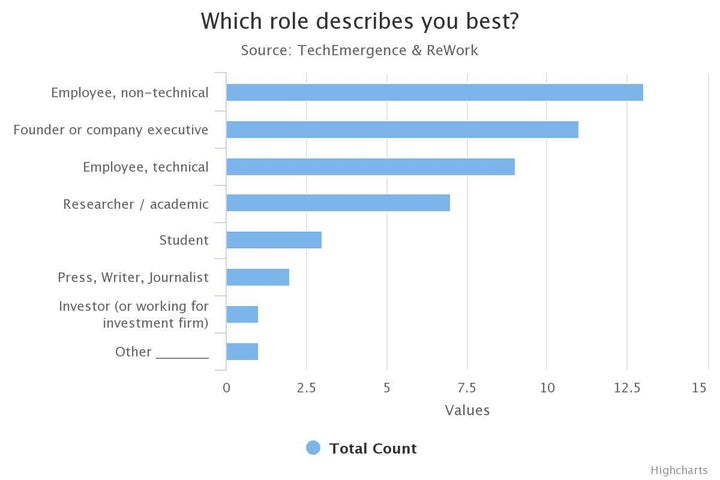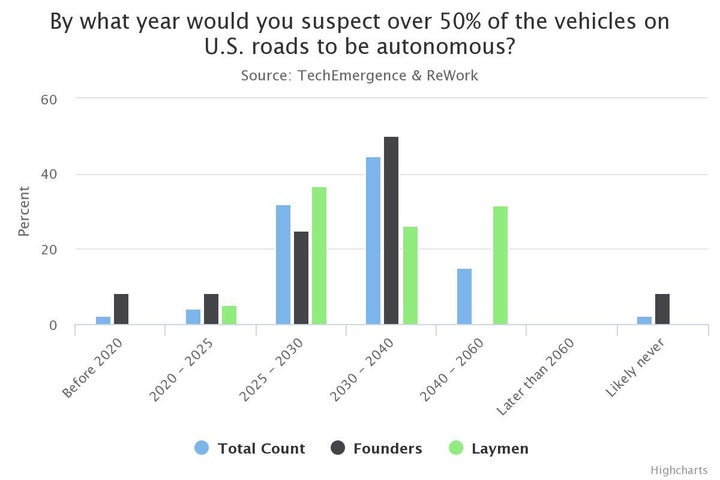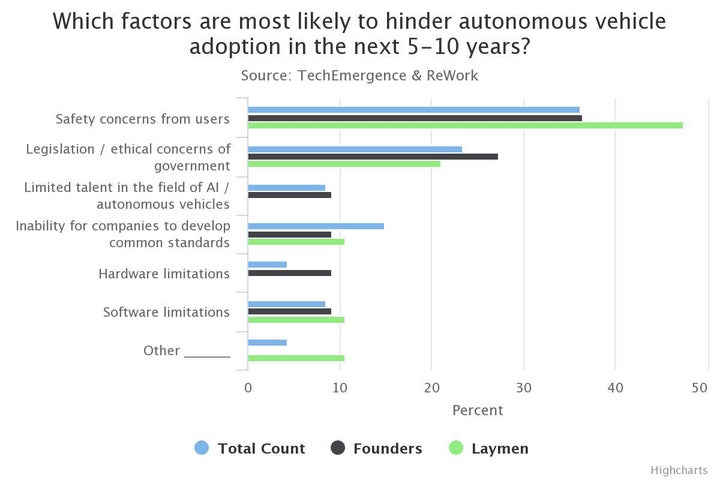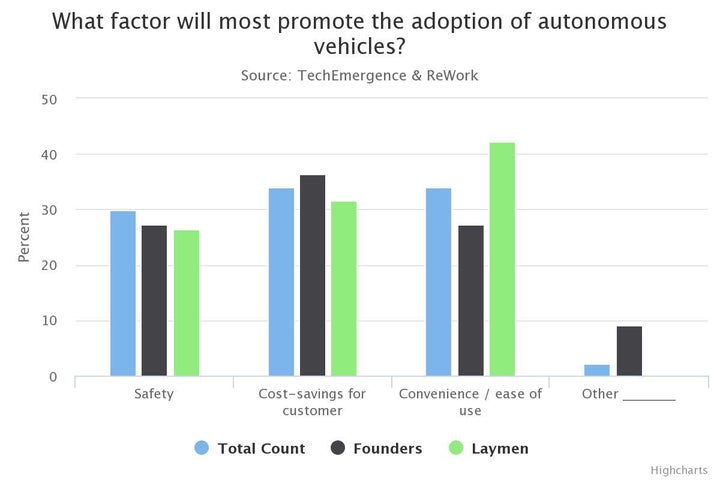Autonomous “Self Driving” Cars have become a topic of public interest in recent years, and recently business leaders have asked us more and more about it’s consequences in industry. Together with London based events organizing company RE•WORK we designed a simple survey that was handed out during their “Machine Intelligence in Autonomous Vehicles Summit” event in San Francisco on March 2017. Below are the responses to this survey, and our interpretations and gleaned ideas.

TechEmergence founder Daniel Faggella interviewing Dr. Sam Kherat of Bradley University at the RE•WORK 2017 Autonomous Vehicles Conference
In the interactive graphs below, we explore the survey responses from 47 attendees of the Summit, aiming to answer industry specific questions and offer predictions for the future of self driving cars in the coming years.
How the Interpret the Research Findings, Charts, and Graphs
The research below is broken down into a number sections, including:
- A chart or graph representing the visual data, often with interactive “segments” that readers can click to explore
- A “Noteworthy Insights” section that highlights the key findings of each section
- (When applicable) Quotes from autonomous vehicle industry experts
Demographic Overview of Respondents: Job Roles

Noteworthy Insights:
- The above data gives a good overall picture of which kinds of roles and employee titles participated in this survey. Non-technical employees, founders, and executives make up the majority of responses (51% of 47 total respondents).
- In the graphs below, we have further segmented respondents into two categories, Founders and Laymen. In the following graphs below, Founders represent respondents who identified themselves as “Founders or company executives” above, while Laymen represent the group of respondents who were non-technical employees, students, and journalists (Note here that “Laymen” is not intended to be insulting, I personally have no formal academic training in automotive hardware or AI software and in this case would be considered a “Laymen” in this field).
When Might Autonomous Cars Arrive?

This portion of the survey essentially asked respondents by what date they would expect AI to be used in majority on U.S. roads, a reality that appears to still be many years away according to most respondents. Respondents were provided with multiple choice date ranges to choose from. It is clear, however, that a total majority suspect that half of all vehicles on U.S. roads will be autonomous between the years 2025 and 2040.
We do see a bell curve, seeing most of the consensus around the 2030-2040 range. That is arguably the semblance of the data here that has the cleanest slope and shape to it. In terms of where the sentiment in the air is, it seems that folks that are technically savvy and who aren’t technically savvy but work in technology appear to be hovering around that time frame for when that 50% line is going to be crossed, at least at this event. Nexar Inc founder and CEO Eran Shir weighs in on the future of autonomous vehicles in a recent “AI in Industry” interview:
“In the next 20 or 30 years, we will live in a hybrid world; initially there will be a few autonomous vehicles in specific places and lots of human-driven cars, and then over time it will gradually change, that’s the story, this is not going to be a big bang, if anything because you don’t have enough factories to replace all the vehicles on the road…during that time, we’re going to be in a very peculiar state, in which you’ll have human drivers and autonomous vehicles share the road.”
Noteworthy Insights:
- Founders / executives appear to be more optimistic the during the median date ranges of 2030 - 2040 of this question, while laymen appear to be less optimistic during this range.
- Only 6.39% of total respondents surveyed suppose that autonomous cars will be a majority on U.S. roads before 2025.
- Founders / executives were the only outlier respondents who chose either “Before 2020” or “Likely Never”.
What Companies Will Reap the Rewards of Autonomous Cars?

The graph above asked respondents what type of companies (among a predetermined list) are most likely to see a positive ROI from the adoption of autonomous cars in the next 5 - 10 years.
It is interesting to note that the top overall predictions from all respondents (Total Count) differ significantly from the predictions of founders and executives. The top overall consensus (30% of Total Count) predicted that ride sharing companies such as Uber, Lyft, and Sidecar are the most likely to see positive ROI from self driving cars. In contrast, 27.27% of high level executives and founders predicted top automakers may have a better advantage over ride sharing companies. According to Robert Seidl, Managing Director at Motus Ventures, there may be a common link between the number of “big” exits in the autonomous vehicle space and the number of new companies entering the market. Seidl notes in a recent interview on the “AI in Industry” podcast:
“After Kyle Vogt’s company Cruise Automation in San Francisco was bought by GM for 1 billion dollars...everyone who was in their dorm room working on machine learning...said, ‘Oh I can do a company.’ Hopefully given our background and existing relationships and companies that we have in that space, filter that a bit more appropriately. We see alot of players and alot of players literally came to the table yesterday after they saw the big exits going to Google and car makers… but there are more coming, no doubt.”
Other noteworthy insights:
- Laymen appear to predict “Tech Giants” are poised to have a positive ROI on autonomous vehicles at a higher rate than executives.
- Founders were the only responding group who chose “Other” citing companies such as NVIDIA, Mobileye, and Waymo.
Industry Adoption Predictions: A Closer Look


The graphs above demonstrate both positive and negative factors concerning autonomous vehicle adoption in America. What I think is interesting is the fact that customer concerns (safety, ease of use, and cost savings) are all seen as even keel factors in terms of what is going to coax out adoption. I would have expected one of them to be drastically higher than the others. It’s interesting to see that ease of use is so high in terms of adoption, but that the factors that will hinder it are very much safety.
It seems that a safe autonomous car won’t necessarily coax people to buy one, but an unsafe car will - more than anything else - ensure that they never buy. In my RE•WORK conference interview with Bradley University’s Dr. Sam Kherat, he articulated a plan for companies to share “failure mode” data between each other, so that different automakers can know when sensors fail (i.e. in conditions of snow, with particular ambiguous shapes that may or may not be a person, with specific lighting conditions, etc). That way, says Dr. Kherat, all self-driving car companies could at least have the same grounding in “failure scenarios” (by pooling their research) and so enhance the safety of all drivers and pedestrians without completely giving up their competitive advantage in the market.
“The issue with autonomous driving, when you think about what people are afraid of, is all of those scenarios when a machine makes a wrong decision based on what it senses. In my opinion, that’s something that we may not happen if we have a common understanding of what a machine can do.”
Such a plan may help hedge against that almighty deterrent to autonomous vehicle adoption (safety), but time will tell if automakers will be willing to open the kimono about their research, even if it involves public safety.
The even distribution among respondents for the graph titled “Which company do you suspect will profit most from the adoption of autonomous cars in the next 5-10 years” leads to an interesting possibility. There really wasn’t a great consensus here as to who is going to profit the most -- there are no peaks and valleys here. We don’t see through the roof differences in this respect. The only outlier here is that safety is predicted to be a primary concern for consumers.
It seems like even people that are in the field (at least the ones who attended this event) aren’t really certain as to who is going to come out the back of it reaping the rewards. Maybe it’s the same as any other transition, for example when the internet first came out. Who are really going to be the behemoths? Where is the most economic value going to be created? Those questions seems to be so difficult to tell when things are nascent and I think that is what we are seeing here.
[Graphics for this research were created by J. Daniel Samples of TechEmergence]
